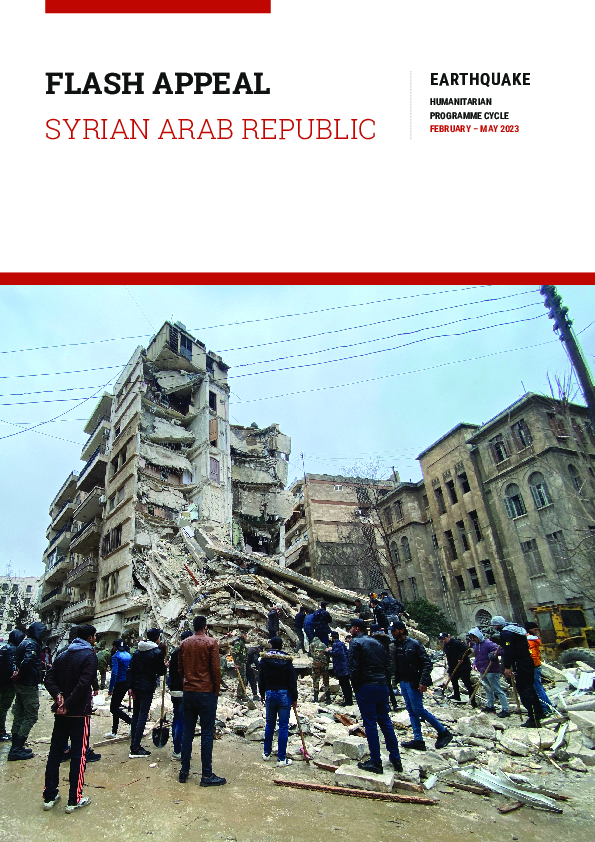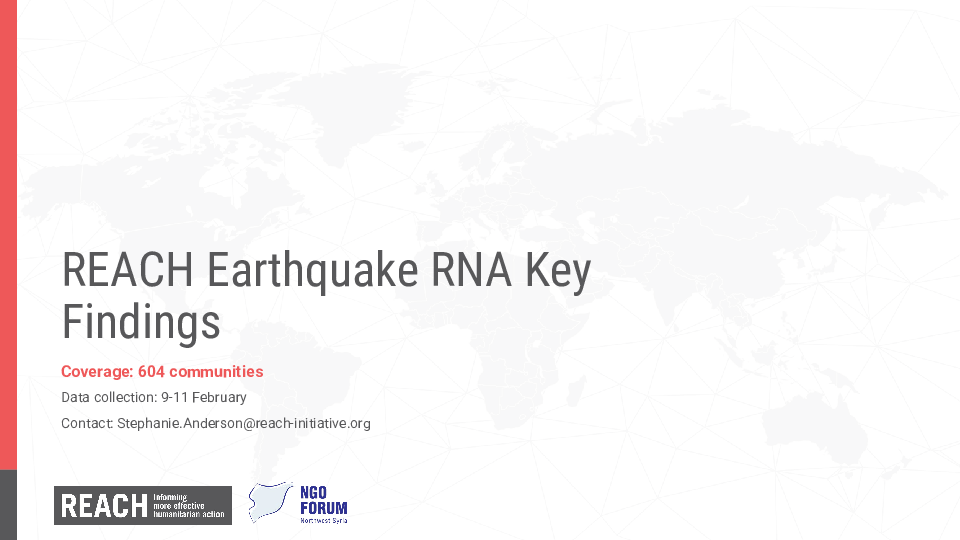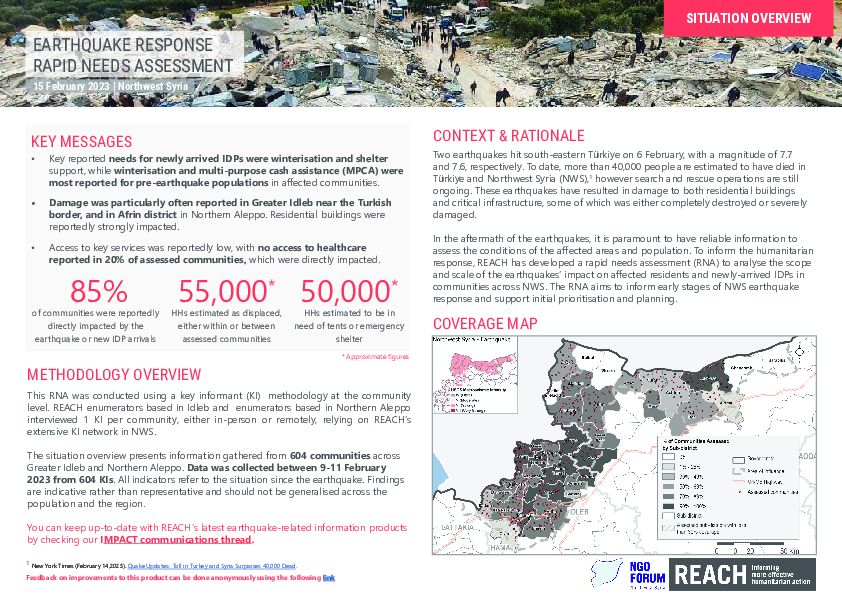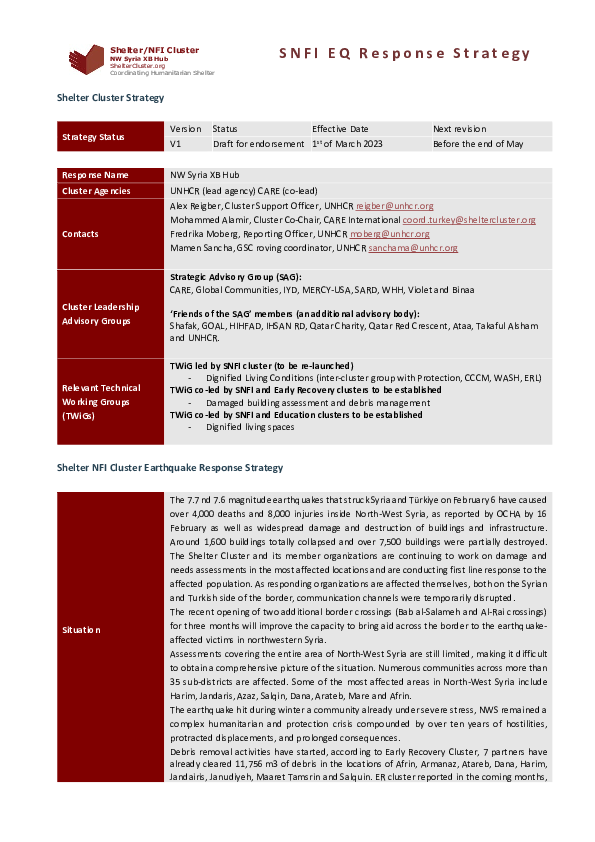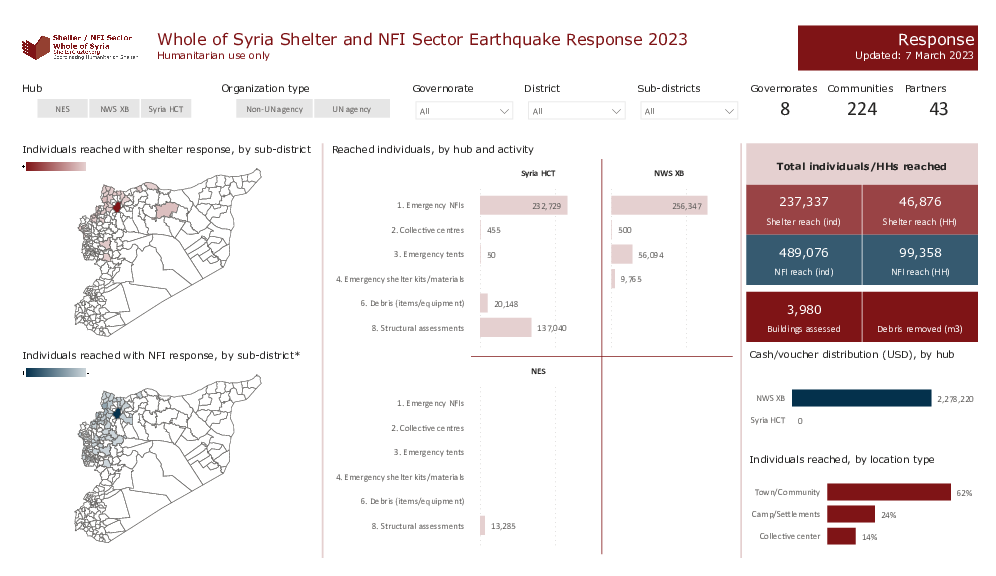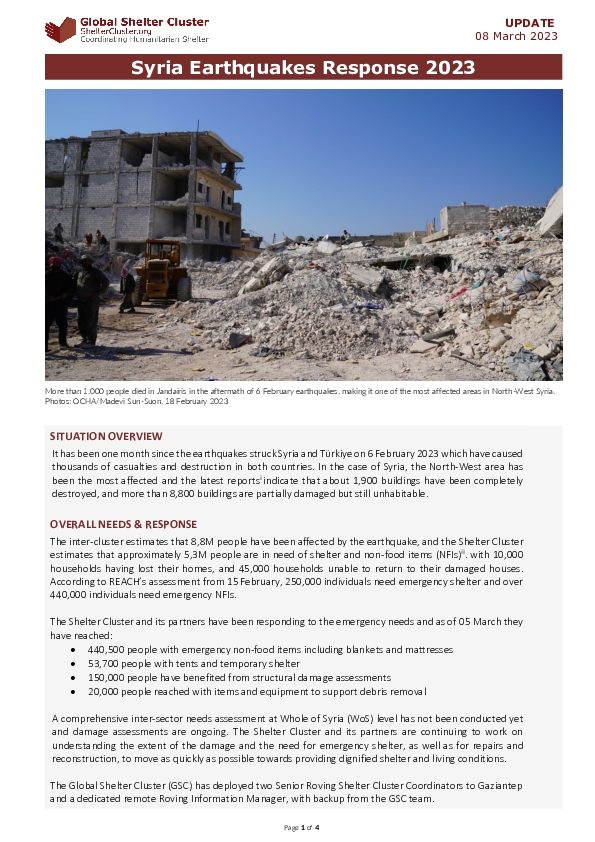Syria Earthquake 2023
Featured Documents
EARTHQUAKE RESPONSE DASHBOARD
OVERVIEW
SITUATION OVERVIEW
It has been one month since the earthquakes struck Syria and Türkiye on 6 February 2023 which have caused thousands of casualties and destruction in both countries. In the case of Syria, the North-West area has been the most affected and the latest reports indicate that about 1,900 buildings have been completely destroyed, and more than 8,800 buildings are partially damaged but still unhabitable.
OVERALL NEEDS & RESPONSE
The inter-cluster estimates that 8,8M people have been affected by the earthquake, and the Shelter Cluster estimates that approximately 5,3M people are in need of shelter and non-food items (NFIs)[1]. with 10,000 households having lost their homes, and 45,000 households unable to return to their damaged houses. According to REACH’s assessment from 15 February, 250,000 individuals need emergency shelter and over 440,000 individuals need emergency NFIs.
The Shelter Cluster and its partners have been responding to the emergency needs and as of 05 March they have reached:
- 440,500 people with emergency non-food items including blankets and mattresses
- 53,700 people with tents and temporary shelter
- 150,000 people have benefited from structural damage assessments
- 20,000 people reached with items and equipment to support debris removal
A comprehensive inter-sector needs assessment at Whole of Syria (WoS) level has not been conducted yet and damage assessments are ongoing. The Shelter Cluster and its partners are continuing to work on understanding the extent of the damage and the need for emergency shelter, as well as for repairs and reconstruction, to move as quickly as possible towards providing dignified shelter and living conditions.
The Global Shelter Cluster (GSC) has deployed two Senior Roving Shelter Cluster Coordinators to Gaziantep and a dedicated remote Roving Information Manager, with backup from the GSC team.
DETAIL NEEDS
Based on preliminary data and associated assumptions, 8,8M people have been affected by the earthquake and 5,3M people are estimated to be in need of shelter and NFIs. Thousands of families are still sleeping out in the open and need urgent shelter assistance. Some have sought refuge in damaged buildings, others with host families including in existing IDP sites and collective centres and new reception centers. Freezing temperatures, snowfall and heavy rain further threatens life and health, particularly in children, elderly and people with pre-existing vulnerabilities.
Overall, 170 sub-districts in 43 districts in ten governorates have been impacted by the earthquakes. The most affected areas include Aleppo Governorate where 4,2M people have been affected to varying degrees and almost 3M people in Idleb Governorate. The districts with the highest number of death and injuries are Harim, followed by Afrin and Jebel Saman.
Structural damage is particularly severe in Idleb and Afrin district in Aleppo. In the Syria Hub, there is no comprehensive assessment as yet, but UNDAC’s assessment highlight that 111 collective centres in Aleppo are hosting 36,200 people displaced by the earthquake. Rapid structural damage assessments are ongoing in Aleppo, Lattakia, Tartous and Hama governorates. In North-East Syria, local authorities are conducting structural assessments to identify buildings deemed safe. In North-West Syria, 77 new reception centres are hosting over 53,700 people affected by the earthquake according to the CCCM Cluster.
The needs range from minor to major repairs through to life-saving emergency shelter and NFI assistance. Of those affected, the SNFI sector estimates that approximately 900,000 people are in urgent need of humanitarian SNFI assistance. Through the Flash Appeal, the SNFI sector aims to target approximately 509,000 people. the SNFI sector aims to target approximately 509,000 people.
DETAILS OF THE SHELTER RESPONSE
The Shelter and NFI response to date can be summarized through the activity table below. This table is based on the activities captured in the Flash Appeal, and include the total number of people targeted per activity, compared to those reached as of 2 March:
|
Activities |
People targeted |
People reached |
|
Activity 1: Adaptation of collective centres for temporary occupancy |
18,000 |
955 |
|
Activity 2: Provision of emergency NFIs |
348,850 |
440,508 |
|
Activity 3: Provision of emergency tents/ temporary shelters |
85,400 |
53,751 |
|
Activity 4: Provision/ installation of emergency shelter kits/ materials |
47,500 |
4,700 |
|
Activity 5: Mobilizing items & equipment to support authorities & debris removal |
25,000 |
20,148 |
|
Activity 6: Support structural assessments |
51,920 |
149,997 |
Syria Hub
As of 2 March, Shelter Cluster partners have assisted the Syndicate of Engineers and local authorities in structural assessment of damage buildings, and have assessed more than 3,457 buildings in the three most affected Governorates. Shelter partners are assisting local authorities in Aleppo on the feasibility of installing prefabricated housing units to accommodate the affected population.
Shelter partners are implementing adaptation works at 18 collective centres, 9 each in Aleppo and Lattakia to ensure safety, security, privacy, and protection from the elements for thousands of people. NFI partners have reportedly assisted 222,199 individuals with emergency NFI assistance to maintain health, dignity, and personal safety; and enable protection from the prevailing harsh winter conditions.
North-West Syria Cross Border Hub
On 05 March, 28 partners reported completed and ongoing activities. The biggest needs have been reported in the following sub-districts: Jandairis, Dana, Al Bab, Janudiyeh, Afrin and Salqin. Shelter Cluster partners have provided assistance to:
- More than 53,000 individuals, supported with tents;
- More than 110,000 individuals, supported with emergency NFIs;
- Around 4,700 individuals supported with emergency shelter kits.
Two interagency and inter-cluster missions have been undertaken to NW Syria, with the first on 21 Feb consisting of the SNFI Cluster team with OCHA, IOM, UNFPA, WHO including the interim Deputy Regional Humanitarian Coordinator. Subsequently, on 1 March, the SNFI Cluster conducted a technical mission to North-West Syria together with IOM, UNICEF and the WASH Cluster. The purpose of the mission was to assess the shelter conditions in reception centers hosting families displaced by the earthquake in Azaz, Aleppo.
The Shelter/NFI Cluster in collaboration with RedR UK conducted two online training sessions on Shelter Structural Damage Assessments on 24 and 27 February. The training was a condensed session designed for engineers and technical staff.
Debris removal activities have started, according to Early Recovery (ER) Cluster, 7 partners have already cleared 11,756 m3 of debris in the locations of Afrin, Armanaz, Atareb, Dana, Harim, Jandairis, Janudiyeh, Maaret Tamsrin and Salquin. ER cluster reported in the coming months, enormous work will be needed to conduct debris management, including rubble removal activities in Azaz, Jihr Ash Sungur, Jabel Saman, and Al-Bab.
FUNDING
The funding requirement for the first 3 months is 52M USD and currently only 14.5M USD has been funded leaving a gap of 37.5M USD. The Flash Appeal aims to cover an initial period of three months from February to May 2023 and complements the 2022-2023 Syria Humanitarian Response Plan (HRP). Even prior to the earthquakes, the humanitarian response has faced significant and chronic underfunding. All clusters covering north-west Syria were underfunded by the end of 2022 and 48 per cent response funding gap was identified in the last quarter.
Response Strategy
SNFI sector partners will respond through prioritization of emergency shelter & NFI provision to those affected. This is achieved through the identification and adaptation of collective centres to ensure suitability for temporary occupancy in accordance with humanitarian standards. Emergency tents and other forms of temporary shelters will be provided, where needed. NFI kits include core and winter NFI items, such as; winter clothing, rubber boots, mattresses, sleeping mats, high thermal blankets/ sleeping bags, kitchen sets, jerry cans, plastic sheeting, solar lamps, heaters & fuel. NFI assistance will be provided through gift-in-kind or cash-based interventions (where markets are functional and items present).
SNFI sector partners will support households who continue to reside in buildings which have experienced minor damage and have been cleared by authorities as ‘structurally safe’. This assistance will include emergency shelter kit/ material assistance and minor repairs which will support household level safety & security (doors, door frames, locking mechanisms), protection from the elements (window frames, glass, plywood, plastic sheeting), access to basic services (water/ sanitation related plumbing, piping, fixtures & fittings) in addition to household level energy provision. This will be implemented through community based self-recovery and technical guidance (cash-based intervention), direct material provision, and contractor engagement.
SNFI sector partners will assist early recovery and livelihood efforts through mobilizing equipment and undertaking community level debris removal to ensure safe access to/ from communities and buildings (cleared by authorities as being ‘structurally safe’). This will be rolled out through contractor engagement and community mobilization. SNFI partners will also support local authorities and the Syndicate of Engineers to undertake structural assessment of buildings to which people are afraid to return.
Flash Appeal – Shelter and NFI Priority Activities
SNFI SO1.1: Provide life-saving SNFI support to people whose houses have been destroyed/ damaged by the earthquake.
- Adaptation of collective centres for temporary occupancy.
- Provision of emergency NFIs.
- Provision of emergency tents/ temporary shelters.
SNFI SO2.1: Provide life-sustaining shelter support to people whose houses have been damaged by the earthquake.
- Provision/ installation of emergency shelter kits/ materials.
- Undertaking minor repairs to damaged housing.
SNFI SO3.1: Support sectors, authorities and partners with equipment and capacity to undertake relief activities.]
- Mobilizing items & equipment to support debris removal and relief activities.
- Removal of community level debris.
- Support structural assessments.
KEY MESSAGES
The lack of a comprehensive needs assessment, especially for people who are in hosting arrangements, is hindering targeting efforts of sector partners. Much of the aid is being provided to families taking shelter in collective or reception centres, resulting in less support being provided to families in hosting arrangements or in existing IDP sites.
There is a need to scale-up emergency assistance with temporary shelter and emergency NFIs, whilst also starting as soon as possible with dignified shelter assistance, with repairs and rehabilitation, including site improvements. Partners are encouraged to conduct assessments in the affected areas to undertake repairs and rehabilitation of damaged apartment units, for those designated as safe by local authorities.
Donors and the humanitarian community need to consider that the needs go beyond the newly affected people from the earthquake. The situation as reflected in the HRP 2023 is and has been dire for the past 11 years for people constantly being displaced by ongoing conflict, affected by harsh weather conditions and almost non-existent livelihood opportunities. The requirement to fund the HRP is critical and should be considered along the lines of the response to the earthquake emergency.
Access to affected areas remains a key challenge, with debris and infrastructure damage preventing essential humanitarian aid delivery. This is exacerbated by extremely cold and wet conditions, that have prevented access to some affected areas. Additionally, until the opening of 2 new crossing points on the Turkish-Syrian border on 16 February, the arrival of humanitarian goods only through one point hampered the humanitarian response.

